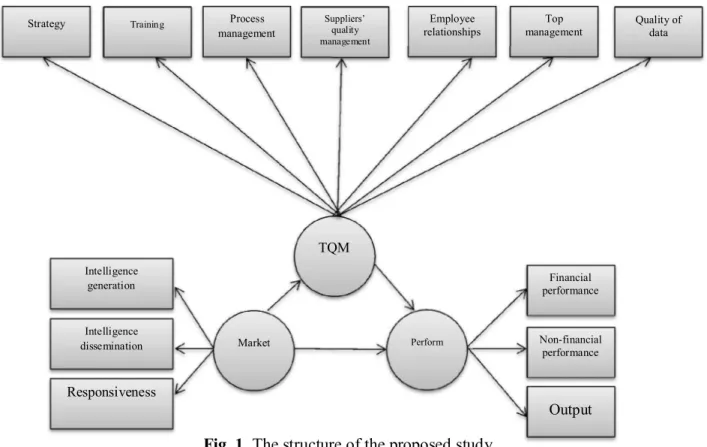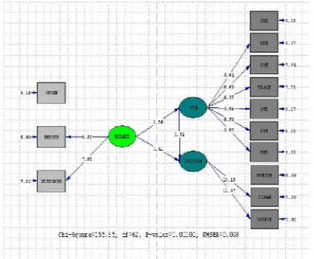*Corresponding author. Tel: +98-9171927206
E-mail addresses: hadiabdollahi34@yahoo.com (H. Abdollahi) © 2014 Growing Science Ltd. All rights reserved.
doi: 10.5267/j.msl.2014.4.001
Management Science Letters 4 (2014) 887–892
Contents lists available at GrowingScience
Management Science Letters
homepage: www.GrowingScience.com/msl
TQM and market orientation's impact on SMEs' performance
Hadi Abdollahia*, Kamal Razmb and Hamid Rouin Tanb
aM.A. Student of Business Management, Allameh Tabatabaei University, Tehran, Iran bM.A. of Business Management, Allameh Tabatabaei University, Tehran, Iran C H R O N I C L E A B S T R A C T
Article history:
Received December 28, 2013 Accepted 28 March 2014 Available online April 3 2014
This paper presents an empirical investigation to study the impact of total quality management (TQM) as well as market orientation on organizational performance on some Iranian small and medium enterprises (SMEs). The study designs a questionnaire in Likert scale and distributes it among some experts in city of Shiraz, Iran. Using structural equation modeling, the study determines that three components of market orientation including intelligence generation, intelligence dissemination, and responsiveness through TQM influences on organizational performance components including financial and non-financial performance as well as efficiency. In addition, TQM components including training, process management, supplier quality management, employee relationships, quality of data and reports and top management commitment influence positively on organizational performance in SMEs.
© 2014 Growing Science Ltd. All rights reserved. Keywords:
TQM
Organizational performance SMEs
Market orientation
1. Introduction
performance as well. In their survey, market orientation maintained the mediating effect between TQM and hotel performance and external environment factors played a moderator between TQM, market orientation and hotel performance, especially when external environment factors bigger changes were going to help to construct relationship with customer, to enhance hotel performance and further to achieve the success for hotel industry.
Raju et al. (2011) investigated MO specifically in the context of SMEs. They performed an in-depth review of the extant literature to develop a conceptual framework by exploring the major antecedents of MO, the MO–Performance relationship, and the key mediators and environmental moderators of this relationship. They also examined various studies on SMEs in terms of different perspectives of this framework.
Bayraktar et al. (2009) examined a framework detecting the causal links among supply chain management (SCM) and information systems (IS) practices, SCM–IS related inhibiting factors and operational performance in Turkey. They also investigated the moderating impact of SCM and IS related enabling factors on the relationships. They reported that both SCM and IS practices positively and significantly impact on the operational performance. They also reported a strong support for negative relationships between SCM–IS related inhibitors and the implementation levels of both SCM and IS practices. In addition, a strong support was detected for the hypothesized negative relationship between SCM–IS inhibitors and operational performance of SMEs.
González-Benito and González-Benito (2005) considered the effects of cultural and operational approaches for measuring market orientation; the objective and subjective measures of performance; and the source of information in the organization, specifically the perspective of production and operations. They reported a positive relationship for operational market orientation and subjective performance. In addition, the adoption of ‘operational recipes’ of market orientation by the production and operations function appeared to improve organizational performance regardless of the existence of any cultural support for market orientation.
2. The proposed study
This paper presents an empirical investigation to study the impact of total quality management (TQM) as well as market orientation on organizational performance on some Iranian small and medium enterprises (SMEs). The study designs a questionnaire in Likert scale and distributes it among some experts in city of Shiraz, Iran. The proposed study considers the following four hypotheses,
1. Market orientation maintains a positive and meaningful impact on TQM on SMEs.
2. Market orientation maintains a positive and meaningful impact on organizational performance on SMEs.
3. A good TQM implementation had positive and meaningful impact on organizational performance on SMEs.
4. TQM is a mediator on relationship between market orientation and business performance.
Fig. 1. The structure of the proposed study
According to Fig. 1, three components of market orientation (Market) including intelligence generation (INGEN), intelligence dissemination (INDISS), and responsiveness (RESPONSE) influences positively on TQM and organizational performance (Perform) including financial performance (FINAN), non-financial performance (NONFIN) and output (OUTPUT). In addition, in Fig. 1, there are seven components associated with TQM including training, process management, suppliers’ quality management (SQM), employee relationships (EMR), quality of data and reports (QDR) and top management commitment (QUP). The proposed study uses a standard questionnaire introduced originally by Demirbag et al. (2006) in Likert scale. The study uses structural equation modeling for the analysis of the data and the results are validated based on Cronbach alpha and some other statistical test. The sample size is calculated as follows,
2 2
2 /
e q p Z
N , (1)
where N is the sample size, p1qrepresents the probability, z/2is CDF of normal distribution and finally is the error term. For our study we assumep0.5,z/2 1.96and e=0.05, the number of
sample size is calculated as N=386. The propsoed study has distributed 400 questinnaires among experts who resided in city of Shiraz, Iran. Fig. 1 shows details of the personal characteristics of the participants. As we can observe from the results of Fig. 1, 81% of the participants were male and only 19% of them were female. In terms of age, most of the participants were middle age, married and highly educated people.
Market Perform
TQM
Intelligence generation
Intelligence dissemination
Responsiveness
Output Non-financial
performance Financial performance Employee
relationships
Suppliers’ quality management
Process management
Training
Strategy Top
Gender Age Marital status Fig. 1. Personal charactersitics of the participants
Table 1 shows details of Cronbach alpha and AVE for different components of the survey. Table 1
The summary of mean factor loading and AVE
Priority Variable Cronbach alpha AVE Mean of factor loading
1 Intelligence generation 726 0.43 0.62
2 Intelligence dissemination 739 0.46 0.65
3 Responsiveness 706 0.59 0.63
4 Quality of data 793 0.56 0.58
5 The role of Top management 817 0.55 0.62
6 Employee relationships 827 0.45 0.66
7 Supplier relationships 764 0.53 0.56
8 Training 822 0.61 0.59
9 Qualitative strategies 751 0.59 0.77
10 Process management 822 0.54 0.75
11 Financial performance 780 0.66 0.78
12 Non-financial performance 769 0.42 0.63
13 Output 710 0.5 0.67
Total 0.77
We have applied structural equation modeling and Table 2 demonstrates the summary of some basic statistics associated with the SEM implementation.
Table 2
The summary of some basic statistics associated with SEM implementation
Attribute Value Desirable limit
Chi-Square/df 2.36 Less than 3
GFI 0.917 Greater than 0.9
RMSEA 0.098 Less than 0.1
CFI 0.972 Greater than 0.9
AGFI 0.869 Greater than 0.9
NFI 0.912 Greater than 0.9
NNFI 0.962 Greater than 0.9
As we can observe from the results of Table 2, all statistical observations are within acceptable limits, which verify the overall test.
3. The results
In this section, we present details of our findings on testing various hypotheses of the survey based on the SEM implementation on LISREL software package.
81
Male Female
58 33
25--34 35--44 45--54
79
The results of standard values The results of t-student values
Fig. 2. The results of SEM implementation
Based on the results of Fig. 2, all t-values are within acceptable limits and we can confirm four hypotheses of the survey.
4. Discussion and conclusion
In this paper, we have presented an empirical investigation to study the impact total quality management as well as market orientation on organizational performance on some Iranian small and medium enterprises (SMEs). The study designs a questionnaire in Likert scale and distributes it among some experts in city of Shiraz, Iran. Table 3 demonstrates the summary of testing the first three hypotheses of the survey.
Table 3
The summary of testing hypotheses of the survey
Hypothesis t-value β R2 Result
First 5.66** 0.62 0.768 Confirmed
Second 5.41** 0.88 0.678 Confirmed
Third 2.51** 0.45 0.711 Confirmed
** Sig< 0.01
Based on the results of Table 3 we can confirm that the first three hypotheses of the survey. Therefore, market orientation maintains a positive and meaningful impact on TQM on SMEs, market orientation maintains a positive and meaningful impact on organizational performance on SMEs and finally, a good TQM implementation had positive and meaningful impact on organizational performance on SMEs. Because of the significant relationship between market orientation and total quality management and total quality management and organizational performance on one hand and a meaningful relationship between market orientation and organizational performance is significant on the other hand, the last hypothesis of the survey has also been confirmed.
Acknowledgement
impact of information systems and supply chain management practices on operational performance: evidence from manufacturing SMEs in Turkey. International Journal of Production
Economics,122(1), 133-149.
Demirbag, M., Koh, S. L., Tatoglu, E., & Zaim, S. (2006). TQM and market orientation's impact on SMEs' performance. Industrial Management & Data Systems, 106(8), 1206-1228.
González-Benito, Ó., & González-Benito, J. (2005). Cultural vs. operational market orientation and objective vs. subjective performance: Perspective of production and operations. Industrial
Marketing Management, 34(8), 797-829.
Li, Y., Liu, Y., & Zhao, Y. (2006). The role of market and entrepreneurship orientation and internal control in the new product development activities of Chinese firms. Industrial Marketing
Management, 35(3), 336-347.
Li, Y., Zhao, Y., Tan, J., & Liu, Y. (2008). Moderating Effects of Entrepreneurial Orientation on Market Orientation‐Performance Linkage: Evidence from Chinese Small Firms*. Journal of small
business management, 46(1), 113-133.
Liao, S. H., Chang, W. J., Wu, C. C., & Katrichis, J. M. (2011). A survey of market orientation research (1995–2008). Industrial Marketing Management,40(2), 301-310.
Raju, P. S., Lonial, S. C., & Crum, M. D. (2011). Market orientation in the context of SMEs: A conceptual framework. Journal of Business Research,64(12), 1320-1326.
Wang, C. H., Chen, K. Y., & Chen, S. C. (2012). Total quality management, market orientation and hotel performance: the moderating effects of external environmental factors. International Journal


